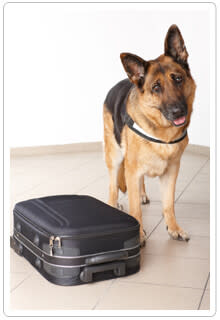
With the real estate market bouncing back in some areas, more households are relocating. With all of the stress of packing, financial concerns, and re-organizing your life, it’s important to take a few steps to make the transition a little easier and safer on your moving companion, your pet. After all, moving to a new home can be confusing and scary to a pet who doesn’t yet know what he’s being dragged into. But, there are a few easy steps to keep him safe and make the transition less upsetting.
Plan Ahead
Before you head to a new neighborhood, city, or state, be sure to have the contact information for the local emergency veterinary hospital on hand. If you’re going to need a new primary care vet, have one lined up and have your pet’s documents transferred to the new hospital in advance. Moving far away? Fill any prescriptions in advance and be sure to pack plenty of food, water, and an emergency kit for your travel.
If you’re making a major move, find out how your new climate can affect things like flea, tick, and heartworm concerns. Are their policies or laws within your new city or homeowner’s association that may affect your pet? If you’re leaving the country, what medical precautions are required?
Secure your Valuables
With all the chaos of moving furniture and having strangers around, moving day can be quite traumatic for your pet. Many pets resort to door dashing to escape the craziness and can find themselves lost! All it takes is one mover or worker leaving a door open.
It’s vitally important to make sure your pet is wearing current identification at all times. Even if you have to write your phone number on his collar, it’s key to getting him returned to you. But, as an added safety measure, it’s best to crate or kennel your pet in a quiet, familiar place, such as a bathroom. Better yet, see if a friend can take your pet for the day, so he can avoid the drama entirely.
When moving day comes, be sure to secure the pet carefully in the car. Crate or carrier is best, but travel harness is another option. And don’t assume that just because you can let your dog off-leash around the old neighborhood that the same rules apply in the new area. If left unsecured, some pets might try to head back to familiar territory.
Create a Haven
Once you’re in the new home, consider unpacking your pet’s comfort items first. Having his bowls, bed, litter box, and favorite treats or toys can be a solace in a strange, new place. Tour the property carefully to make sure there are no holes in fencing, loose boards, or other safety concerns. It’s normal for some pets, especially cats, to hide out behind furniture or a water heater for a few days while they acclimate. Just be sure they have access to their food and water when they do come out for a quick look around.
Even though you’re exhausted after a long day of shuffling boxes, take a few minutes to play with your pet or walk him around his new neighborhood. A little TLC can reassure your pet that all the fun will continue, just in a new place.